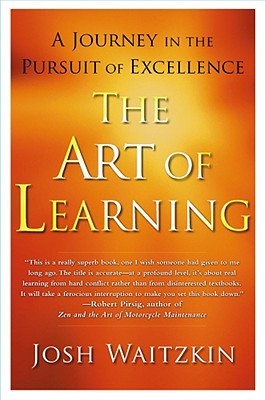
Josh Waitzkin was an American chess prodigy. The movie Searching for Bobby Fischer was based on his life story. Josh left chess at the age of around 20 and shifted to learning Tai Chi from a renowned teacher. His teacher encouraged him to explore Tai Chi Push Hands, a martial arts form of Tai Chi, in which he then became a world champion! Josh is also a black belt in Brazilian Jiu-Jitsu.
In 'The Art of Learning', Josh Waitzkin recalls what he learned all these years pursuing chess and Tai Chi. Each chapter of his book showcases a strategy for high performance.
In one chapter, Josh mentions that he was surrounded by child prodigies from childhood. Some of these prodigies went on to become successful champions later, some did not. A major contributing factor was how they were taught to perceived their success by their parents. Some children were told that they were inherently 'smart', others were told that they were 'hardworking'. The 'hardworking' kids were able to handle failures in life much better! This article describes psychological research that explores this phenomenon.
Another chapter is on relaxation. When Josh was a chess champion, he visited an academy where champions from various fields converge to learn how to sustain their high levels of performance, year after year. He was questioned by many experts at the academy. One question which stumped him was: “Do you win more games when you’re relaxed or when you’re stressed?” Josh didn’t know the answer. So he went back to his notes and figured out that he indeed won more games when he was relaxed! This insight was powerful and motivating. The next question was: how could Josh become relaxed before or even in the midst of a chess game? His coach at the academy asked him to pick up running, especially fartlek where one runs very fast for a short burst of time. When you’re running so fast, you cannot think about chess because you’re focused on your body movements, your breath, your muscles and your being, in general. So Josh used to take a break to go for a swift run in between his games. Later, he devised a ritual, a sequence of physical activities, prior to the run and discovered that merely doing the ritual was sufficient to provide him the kind of relaxation he got from actually running.

Shinichi Suzuki pioneered the Suzuki Method for learning the violin. The book 'Nurtured by Love' has no chapters, simply a series of short passages. Each passage recounts an event in his personal life, describing what he or others learnt from that event. For example, on Page 79, he narrates what he learnt from Albert Einstein:
What else do I remember from this book? Shinichi Suzuki emphasized that to be a top notch musician, one has to go beyond technical virtuosity by imbuing music with 'feelings'! Music is simply a medium for expressing our true selves, so our emotions must meld with the instrument we are playing or the composition we are singing.

I really love this book! Many people imagine that marathon running is about physical preparation. Nope! Running a marathon is a lot about mental fitness. This book emerged from marathon training classes conducted at the University of Iowa over a ten year period. In each class, a psychological techniques was taught to students. These techniques actually go beyond marathon training — they are life skills in general.
One of the first instructions given to students was to buy a pair of shows and register for a marathon. Then start telling everybody, "I am a marathoner. I will finish a marathon in sixteen weeks from now!". By week five, make the narrative longer: "I am a marathoner. I love running! I never get tired. I never quit on a run. I run four times a week and I never miss a training run. I love to run on hills. I run no matter what the weather is like. I will finish a marathon in eleven weeks from now!". Each of these is a firm, positive statement, exuding confidence and beaming with joy!
Another technique in the book is for handling situations when doubts arise. Consider days when the following thoughts creep up: "My legs are really tired today", "The weather is really rotten today", "My legs are sore today". Instead of using such statements as excuses to avoid training on that day, we must simply the presence of these (negative) thoughts, and append the following to each thought: "... but it doesn't matter!" :) This is a powerful technique.
Another idea in the book: do not have limiting thoughts like 'The maximum I can run is ten miles', or 'I can run only at 5mph'. Instead, be open to possibilities! In the context of this idea, the personal story of Mark Block is the most inspiring story in the book. He was an athlete who was in a serious accident, flying out of the windshield of a car, with his spinal cord cut in multiple places. When he woke up in the hospital, his body was paralyzed below his neck. However, his brain functioned just normally. Doctors opined that it would be a miracle if Mark will be able to feed himself ever. However, Mark was fully convinced that he will be able to 'rewire' the rest of his body to be able to resume his activities. Several months later, with the help of extensive therapy, Mark surprised everybody by walking out of the hospital with a cane! Later, when he heard of the marathon training class, he signed up for the class. On the first day of the class, he was still limping and using a cane for support. At the end of the course, Mark didn't run a marathon but he did walk 15 miles!

Timothy Gallwey observed tennis students he was coaching and identified several principles that contribute to improvements. These principles go beyond tennis — they are useful in general situations that life presents us.
Positive thinking is one of the first chapters in the book. Gallwey observed that after a bad serve, some students would castigate themselves with statements like "Uh, I will never improve!", "Why am I such a loser?", "I should have tried harder". Students engaging in such talk never improve beyond a threshold. Their progress is hampered. Instead of beating yourself up verbally, the right approach is to have self compassion, to be gentle with yourself and keep on trying. Those familiar with the 10-day meditation camps by S N Goenka may remember his sentence "Gently bring your mind back to your breath." It's the same concept.
In another chapter, Timothy talks about 'non-thinking'. Physical art forms like dancing and playing tennis are best done without 'thinking' like 'flow' activities.

Lanny Bassham was a rifle shooter who could not win the gold medal at the 1972 Olympic Games. He had a mental failure and could not perform to the best of his ability that day. Frustrated, he started asking other champions how they performed under pressure. He summarized his findings into a system called 'Mental Management'. Armed with these techniques, Lanny Bassham dominated his sport for the next six years. He won 22 world individual and team titles, setting 4 world records and winning the coveted Olympic Gold Medal in Montreal in 1976. The book 'With Winning in Mind' lays out his technique. It is replete with firm, positive statements! A good read.
Lanny ends the writeup with the following para:

This book is inspiring. It sets very high standards for teachers of any kind. I did not read this book fully. From what I read, I remember a couple of things. First, Gilbert Highet defines the goal of teaching: to help a student achieve his / her maximum potential — that's awesome! Second, there are many different ways of teaching. When I was growing up, I was exposed to only one style: teachers used to give lectures, homeworks and written examinations. Another way of teaching is through asking questions — Socratic teaching — this requires that the teacher be really knowledgeable about the subject! Another way is to ask a student to write an essay and to repeatedly refine the essay until it is polished.

